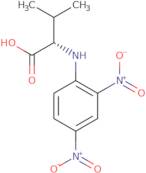N-(2,4-Dinitrophenyl)-L-valine
CAS : 1694-97-9
Ref. 3D-BAA69497
| 1g | Arrêté | ||
| 5g | Arrêté | ||
| 10mg | Arrêté | ||
| 100mg | Arrêté | ||
| 250mg | Arrêté | ||
| 500mg | Arrêté |
Informations sur le produit
- <span class="text-smallcaps">L</span>-DNP-Valine
- <span class="text-smallcaps">L</span>-Valine, N-(2,4-dinitrophenyl)-
- DNP-<span class="text-smallcaps">L</span>-valine
- DNP-L-Valine 2,4-Dinitrophenyl-L-valine
- Dinitrophenylvaline
- N-(2,4-Dinitrophenyl)-<span class="text-smallcaps">L</span>-valine
- N-(2,4-dinitrophenyl)valine
- N-2,4-DNP-<span class="text-smallcaps">L</span>-valine
- NSC 89621
- Valine, N-(2,4-dinitrophenyl)-, <span class="text-smallcaps">L</span>-
- Voir d'autres synonymes
- L-Valine, N-(2,4-dinitrophenyl)-
- N-2,4-DNP-L-valine
- Valine, N-(2,4-dinitrophenyl)-, L-
- DNP-L-valine
N-(2,4-Dinitrophenyl)-L-valine is a membrane transport substrate. It is used for the separation of choline from other amino acids and for the detection of hydrochloric acid in test samples. N-(2,4-Dinitrophenyl)-L-valine has been shown to be effective at low concentrations in toroidal on-line ion exchange chromatography for the separation of choline from other amino acids. The compound can also be used as a standard to determine the concentration of hydrochloric acid in test samples. This chemical is biodegradable and not considered toxic, due to its structural similarity to zymogen.





